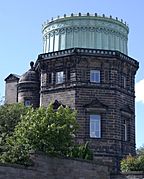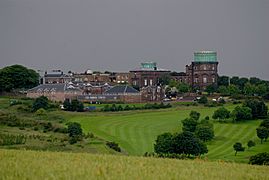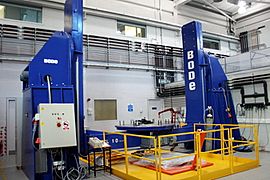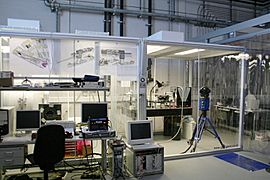Royal Observatory, Edinburgh facts for kids
The Royal Observatory, Edinburgh (ROE) is a famous place in Edinburgh, Scotland, where people study space and stars. It's located on Blackford Hill. The Science and Technology Facilities Council (STFC) owns the site.
The ROE is made up of a few important parts:
- The UK Astronomy Technology Centre (UK ATC), which is part of STFC.
- The Institute for Astronomy, which belongs to the University of Edinburgh.
- The ROE Visitor Centre, where the public can learn about space.
Scientists at the observatory do research about space and teach university students. They also design and build special instruments and telescopes for other observatories around the world. The ROE also helps train teachers in astronomy and offers fun activities for the public.
The ROE has a special library called the Crawford Collection. It has many old and rare books about astronomy. Before moving to its current spot in 1896, the Royal Observatory was on Calton Hill, closer to the center of Edinburgh. That old site is now called the City Observatory.
Quick facts for kids Royal Observatory, Edinburgh |
|||||||||
|---|---|---|---|---|---|---|---|---|---|

Gate and East Tower
|
|||||||||
| Organization | Science and Technology Facilities Council University of Edinburgh |
||||||||
| Code | 277 | ||||||||
| Location | Blackford Hill, Edinburgh, Scotland, United Kingdom | ||||||||
|
Coordinates
|
55°55′23″N 3°11′16″W / 55.92306°N 3.18778°W
|
||||||||
| Altitude | 146 m | ||||||||
| Established | 1896 | ||||||||
|
|||||||||
Contents
History of the Royal Observatory
Early Days on Calton Hill
The University of Edinburgh started a special astronomy teaching position in 1785. Later, in 1811, some private citizens created the Edinburgh Astronomical Institution. They bought land on Calton Hill to build an observatory. This building, designed by William Henry Playfair, is still there today.
In 1822, King George IV visited Edinburgh. He gave the observatory the title "Royal Observatory of King George the Fourth." By 1834, the observatory had all its equipment. Thomas Henderson became the first Astronomer Royal for Scotland. The main telescopes there were a 16 cm transit telescope and a 9 cm azimuth circle.
In 1852, Charles Piazzi Smyth, the second Astronomer Royal for Scotland, had a new idea. He thought observatories should be built on high mountains with clear weather. He even traveled to Tenerife to test this idea. This became a common practice much later.
The observatory also started a time service in 1858. They used observations of stars to keep their clock very accurate. This clock was connected to a time ball on Nelson's Monument. This ball would drop at a certain time, helping ships in the port of Leith know the exact time. Another wire went to a time gun at Edinburgh Castle, which would fire at 1 PM.
The government didn't give enough money to the observatory. Because of this, Smyth resigned in 1888. The government then planned to close the Royal Observatory completely.
| Asteroids discovered: 7 | |
|---|---|
| (6222) 1980 PB3 | 8 August 1980 |
| (14801) 1980 PE3 | 15 August 1980 |
| (22262) 1980 PZ2 | 4 August 1980 |
| (24625) 1980 PC3 | 8 August 1980 |
| (29086) 1980 PY2 | 4 August 1980 |
| (52241) 1980 PW2 | 4 August 1980 |
| (129439) 1980 PX2 | 4 August 1980 |
Moving to Blackford Hill
When the Earl of Crawford heard about the plans to close the observatory, he made an offer. He said he would give his own observatory's instruments and his amazing astronomy library to the country. But only if the government built a new Royal Observatory.
Ralph Copeland became the third Astronomer Royal for Scotland. He managed the move of instruments from both the Earl's observatory and the old Calton Hill site to Blackford Hill. The new observatory opened in April 1896.
The new domes received a 38 cm refractor (East Dome) and a 0.6 meter reflector (West Dome). A 22 cm transit circle was placed in another building. The time service continued, controlling the time ball and time gun. It also controlled a time gun in Dundee and a clock at Rosyth dockyard. In the early 1900s, the ROE helped create more accurate pendulum clocks. These were used until the 1960s when quartz clocks took over.
On May 21, 1913, a bomb was set off by suffragettes at the observatory. No one was hurt, but there was damage to the floors and stone walls.
In the first half of the 20th century, the ROE started using new methods. They used photography and light sensors to record star positions, brightness, and spectra (the colors of light from stars). From the 1950s, the ROE focused more on building instruments and using automation.
Building and Supporting Telescopes Worldwide
From 1961 to 1973, the ROE had an outstation called Earlyburn. It was used to track artificial satellites. From 1967 to 1976, they also operated a Schmidt camera near Rome, Italy. Over time, the ROE became more focused on running and supporting large national telescopes.
The ROE operated the UK Schmidt Telescope (UKST) from 1973. This telescope took photos of the entire southern sky. These photos, combined with others, created a huge map of the sky. In 1988, the telescope was given to the Anglo-Australian Observatory. The ROE kept the photographic lab and plate library for the UKST in Edinburgh.
Since 1967, the ROE had a machine called GALAXY to turn photographic plates into digital data. This machine was improved in 1975 and became COSMOS. It worked until 1993 and was replaced by a new SuperCOSMOS machine.
Between 1973 and 1979, the ROE built the 3.8-meter UK Infrared Telescope (UKIRT) in Hawaii. This telescope was one of the first to use thin mirrors. The ROE operated UKIRT with the University of Hawaii. They also built instruments for it, including the first infrared camera for general use. In 1987, the James Clerk Maxwell Telescope (JCMT), also in Hawaii, was given to the ROE. The JCMT is a 15-meter telescope that studies very long wavelengths of light.
Changes and New Projects
In the 1990s, there were many changes for astronomy in Edinburgh. The Royal Observatories in the UK, including ROE, were brought under one director. In 1994, the ROE became part of the Particle Physics and Astronomy Research Council (PPARC).
In 1995, the observatories were separated again. The ROE lost control of the UKIRT and JCMT. However, it kept its important role in building instruments for telescopes and satellites. It also became the UK office for building the Gemini Observatory. This project involved seven countries building two large 8.1-meter telescopes.
In 1996, there was a review of the Royal Observatories. It suggested that running observatories and building instruments should be open to competition. This caused worry about possible closure. But in 1997, it was decided to combine parts of the Royal Greenwich Observatory (RGO) and the ROE into a smaller astronomy technology center. In 1998, the RGO closed. The ROE kept its technology and project management skills. These were used to form the new UK Astronomy Technology Centre (UK ATC). The name ROE is still used for the UK ATC, the University of Edinburgh's Institute for Astronomy, and the Visitor Centre.
After working on Gemini, the UK ATC managed the building of the 4-meter VISTA telescope. VISTA is a survey telescope that takes wide-field images in infrared light. It is located at the European Southern Observatory (ESO) in Chile. The UK joined ESO in 2002. VISTA was given to ESO in 2009 as part of the UK's membership fee.
Directors of the Observatory
Here are some of the people who led the Royal Observatory, Edinburgh:
- 1834–1844, Thomas Henderson
- 1846–1888, Charles Piazzi Smyth
- 1889–1905, Ralph Copeland
- 1905–1910, Frank Dyson
- 1910–1937, Ralph Sampson
- 1938–1955, W.M.H. Greaves
- 1957–1975, Hermann Brück
- 1975–1980, Vincent Reddish
- 1980–1990, Malcolm Longair
More recent directors of ROE or UK ATC:
- 1995–1997, Stuart Pitt
- 1998–2004, Adrian Russell
- 2005–2012, Ian Robson
- 2012–present, Gillian Wright
The Royal Observatory Today
Telescopes at ROE
The original building from 1894 has two round copper domes on top of the East and West Towers. These were fixed up in 2010. The East Dome still holds a 0.9 meter Cassegrain reflector telescope from 1930. This telescope is part of the visitor center, but it no longer works. A 0.4/0.6 meter Schmidt camera was in the West Dome from 1951. It was moved to the National Museum of Scotland in 2010.
The only working telescope at the ROE is a 0.5 meter reflector. It's in a round dome on top of the teaching labs. University students use this telescope for their classes.
The Crawford Collection
The Crawford Collection has very old copies of important books about the history of astronomy. This includes works by famous scientists like Brahe, Copernicus, Galileo, Kepler, and Newton. Lord Lindsay collected most of these books in the 1870s and 1880s. The collection also includes over 2500 items from Charles Babbage's library.
Visitor Centre Activities
The Visitor Centre at the ROE holds public events. These include talks about astronomy and special open nights where people can look through telescopes. The Observatory also offers classes and training for teachers. They have educational events for both primary and secondary schools.
Gallery
See also
 In Spanish: Real Observatorio de Edimburgo para niños
In Spanish: Real Observatorio de Edimburgo para niños






